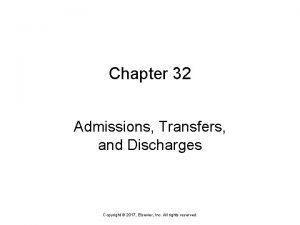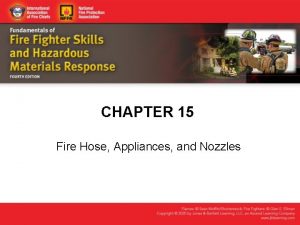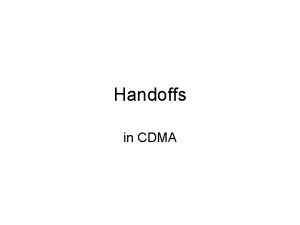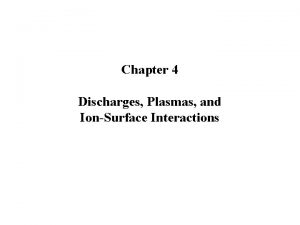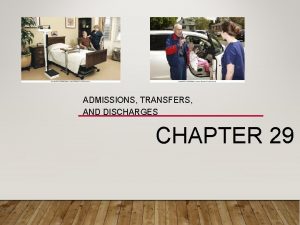Admissions Handoffs and Discharges i e lions and
































- Slides: 32

Admissions, Handoffs, and Discharges i. e. lions, and tigers, and bears, oh my! Ami De. Waters March 7 th 2016

Objectives ▪ Learn the different approaches to doing an admission. ▪ Learn the basic orders for an admission. ▪ Learn how to perform an appropriate sign-out and handoff. ▪ Learn how to write a discharge summary. ▪ Learn how to plan discharges. ▪ Learn several pitfalls of EMR documentation and how to avoid them.

Admissions ▪ You are asked to do an admission – what now? ▪ Three basic ways to do an admission – Start with chart review, see patient, write orders, write H&P – See patient, do chart review, write orders, write H&P – See patient, write orders, do chart review, write H&P ▪ Write your H&P last – It’s time consuming – Don’t delay patient care by not having orders in

Admissions ▪ Note on previous slide – ALWAYS see patient before writing orders – Patient condition can be very different than what you see in the computer ▪ My personal preference (doesn’t mean it’s the only one or better) – Chart review, see patient, write orders, write H&P – It is easier to get a detailed, accurate H&P if you already know something about the patient – It reduces patient frustration – they don’t have to repeat everything ▪ Goal = have orders started within 30 minutes from ED call

Admissions – the electronic medical record ▪ Most EMR’s will have order sets – – Admission order sets Discharge order sets It’s impossible for us to cover all of those here Use these order sets!!! ▪ Save you a lot of time

Admissions – the ADC VAN DISMAL ▪ Admit ▪ Diet ▪ Diagnosis ▪ IVF ▪ Condition ▪ Studies ▪ Vitals ▪ Meds ▪ Activity ▪ Allergies ▪ Nursing ▪ Labs

Admissions – the ADC break down ▪ Admit – Where do they go – ICU, intermediate care, floor? – What do they need – telemetry, continuous pulse oximetry, oxygen? ▪ Diagnosis – The primary thing that brought them into the hospital – This is what you are billing for – and what the auditors are looking at ▪ Condition – Stable, fair, guarded, critical – Guarded and critical patients should not be on the floor!

Admissions – the VAN break down ▪ Vitals – How often – What vitals do you want to be called for ▪ Activity – Is the patient allowed to ambulate freely, or do they need precautions, e. g. fall ▪ Nursing – Is there wound care that the nurse needs to address – Does the patient need turned regularly

Admissions – the DISMAL break down ▪ Diet – NPO (remember med adjustments, such as insulin) – Diabetic diet, renal diet, cardiac diet, etc. ▪ IVF – Do they need any – If so, resuscitative or maintenance ▪ Studies – Any additional imaging/procedures ▪ Medications – ONE OF MOST IMPORTANT – we are internists – this is how we treat people – Must reconcile home medications correctly ▪ Allergies – True allergies, not adverse side effects ▪ Labs – Order certain labs daily vs weekly

Admissions – another conceptual approach ▪ Approach admission orders by working through your H&P – – – – Start with allergies – clarifying and correcting in EMR Move to medications – including IVF Vitals Physical exam give clues to nursing needs and activity guidelines Labs Studies/imaging Work through assessment and plan which should include ▪ ▪ Diagnosis accompanied by condition ( assessment) Diet Disposition Code status

Admissions Let’s Practice!

Sign-outs and Handoffs ▪ Sign-out will occur every day ▪ Handoffs will occur at the end of your rotation to the next team

Sign-outs - approach ▪ Two approaches – Detailed daily progress notes that outline almost all medical conditions ▪ Brief sign out – Detailed sign out ▪ More brief daily progress notes ▪ Your program may very well have a standardized form that they expect you to use

Sign-outs – The “DO’s” ▪ Every sign out MUST contain – Patient name, MRN, and location – Accurate code status – Diagnosis – Medications you DO NOT want the patient to have – How you want problems that may occur overnight addressed – If there is follow-up labs or imaging ordered instructions on what to do with results

Sign-outs – the “DON’Ts” ▪ The major sign-out “no, no’s” – Signing out a patient with no vascular access – rare exceptions – Signing out a patient who needs transfusion without consent filled out – Signing out an unstable patient – DUTY HOURS DO NOT EXCUSE THIS – Signing out family updates – Signing out orders to follow-up on with no instructions – Signing out a patient that is discharged but instructions are incomplete

Sign-outs – the night float ▪ How to be the best night float – Be thoughtful – do not jump to decisions – take the time to read the chart – Keep a thorough record of what you did ▪ Too much information is better than too little in this case – Explain your reasoning for your decisions clearly ▪ Attendings will ask the next day why things are done – WRITE NOTES on significant events

Handoffs - briefly ▪ At the end of a rotation, need to handoff patients to next team ▪ Make daily progress note your last day more detailed ▪ Provide a written handoff with a simple list of the items that need followed ▪ Always ask if intern wants verbal sign-out

Sign-outs and Handoffs Let’s Practice!

Discharges – the written portion ▪ Every part of the discharge think to yourself – “Who am I writing this for? ” ▪ Two major written portions of the discharge – The discharge instructions ▪ To the patient ▪ AND the PCP most likely – The discharge summary ▪ To the PCP ▪ To the next admitting physician

Discharges – the discharge instructions ▪ Essential to communicate to the patient what they need to know – – – – – Remember ADC VAN DISMAL? Work through those for your discharge instructions Tell them their diagnosis and their condition on discharge Tell them if they need to follow vital signs at home What activities are they allowed to do? Drive? Exercise? If they need nursing care and what for (home health) What they can eat If they need any follow-up procedures, imaging or labs What changes to medications have been made

Discharges – the discharge instructions ▪ Please write in simple, understandable language – Do NOT write “please follow a diabetic diet” – Or “take your Lasix PO BID instead of daily” ▪ NOTE: most patients leave the hospital without a discharge summary – They will bring their “discharge paperwork” to the PCP – This will have only the discharge instructions – May want to include a note to the PCP in the discharge instructions with more explicit medical information

Discharges – the discharge summary ▪ So who is this written to again? ▪ SUCCINT AND RELEVANT ▪ The PCP does not care that on day 14 the patient’s blood pressure was 120/80

Discharges – the discharge summary ▪ Organization – Problem-based is acceptable – Narrative format is acceptable – NEVER write in chronological format ▪ i. e. “on day 1…then on day 2…” ▪ Impossible to understand the comprehensive story ▪ Leads to including irrelevant detail

Discharges – the discharge summary ▪ Ami’s paragraph rule – – – Remember grammar – a paragraph is 3 -5 sentences # of weeks of admission + 1 = # of paragraphs in discharge summary Admitted 1 week = 2 paragraphs Admitted 2 weeks = 3 paragraphs You get it…keep it short! ▪ What is relevant? – A PCP wants to know ▪ ▪ ▪ the condition the patient was in when they left The diagnosis Medication changes Labs or imaging that need followed-up on Look familiar? ? ?

Discharges Let’s practice!

Discharges - planning ▪ As an intern your number one best friend should be – Care coordinator or social worker – Know their names, memorize their numbers ▪ Talk to them at least daily ▪ Usually twice (once in the AM and once in the PM) ▪ Services required at discharge need planning and authorization – Your social worker is not a miracle worker – They work in a complicated system that takes a lot of time – You can see were I’m going with this…

Discharge - planning Discharge planning starts on the day of admission!

Discharge - planning ▪ When you admit that 80 year old 250 lb man who can’t walk and is living at home with his 80 year old 90 lb wife what do you do? – Order PT on day of admission to assess if he needs rehab

Discharge - planning ▪ MUST include the following – An appointment with a physician, preferably PCP, within 7 days – A follow-up call three days post-discharge – A system to catch any results that were pending when patient left

EMR Documentation - Pitfalls ▪ Put the time in to learn the tech side of the EMR up front – – There a lot of short cuts that will save you a lot of time later on Order templates Smart phrases Filtering systems ▪ Copy and Paste – the two options – Don’t do it – Or commit to editing very carefully on a daily basis – Ami’s rule ▪ Never copy and paste physical exam – write fresh every day ▪ Can copy and paste assessment and plan with careful editing and not including details that can not be copied and pasted

EMR Documentation - Pitfalls ▪ Do not vent in the EMR – Not the place to let vascular surgery know exactly what you think of them ▪ Likewise, be aware that others will vent in EMR – Do not take it personally – If it is truly inappropriate, report to your attending

The End Whew, that was a lot of information. Any questions?
 Chapter 32 admissions transfers and discharges
Chapter 32 admissions transfers and discharges Mahoin2
Mahoin2 Which hose appliance combines two hose lines
Which hose appliance combines two hose lines Lbcc admissions and records
Lbcc admissions and records Lbcc admissions and records
Lbcc admissions and records Eops gwc
Eops gwc Uc davis admissions portal
Uc davis admissions portal Slu admissions counselors
Slu admissions counselors Admissions funnel
Admissions funnel Coast guard academy admissions
Coast guard academy admissions Cappagh admissions
Cappagh admissions Pine view school admissions
Pine view school admissions Mira costa office 365
Mira costa office 365 Interrogatories sample
Interrogatories sample Hamline university graduate programs
Hamline university graduate programs Graduate admissions usf
Graduate admissions usf Uci admissions office
Uci admissions office University of florida rolling admissions
University of florida rolling admissions University central florida international student insurance
University central florida international student insurance Types of admission hospital
Types of admission hospital Requirements for west point
Requirements for west point Uaf admissions
Uaf admissions Nau graduate admissions
Nau graduate admissions Canyon crest academy admissions
Canyon crest academy admissions Canyon crest academy counseling
Canyon crest academy counseling Cal state dominguez hills tuition room and board
Cal state dominguez hills tuition room and board Admissions to schools act 2018
Admissions to schools act 2018 Victorian tertiary admissions centre founded
Victorian tertiary admissions centre founded Chatt tech dual enrollment
Chatt tech dual enrollment Moraine valley testing center
Moraine valley testing center Bexley school admissions
Bexley school admissions Gus.uams
Gus.uams The door david hammons
The door david hammons
